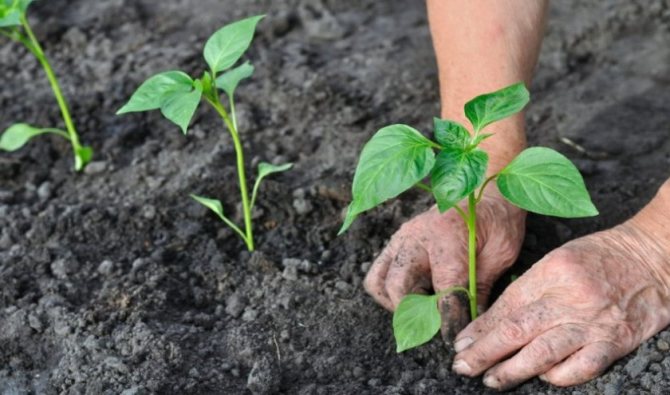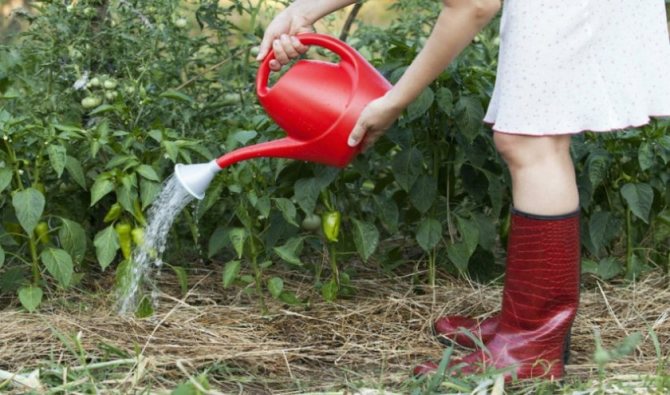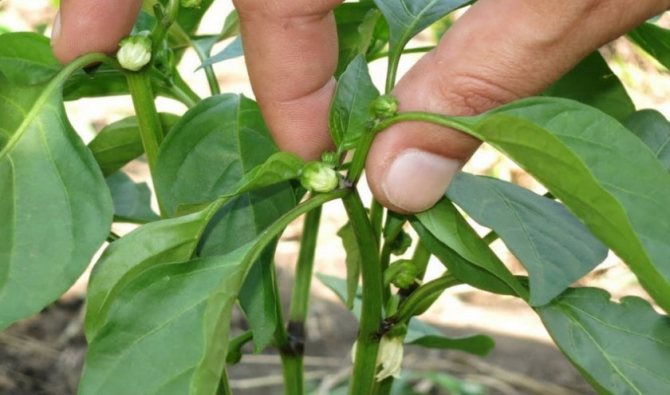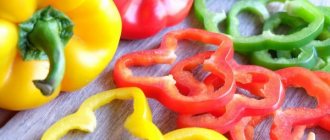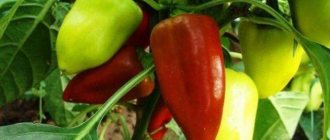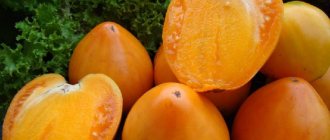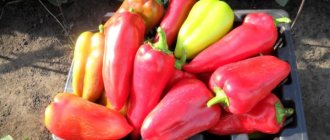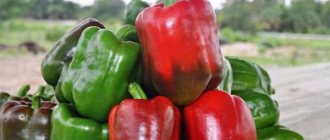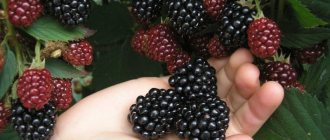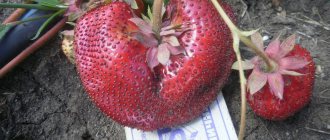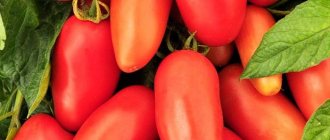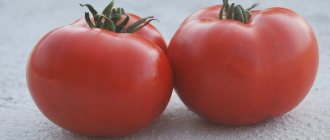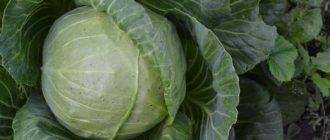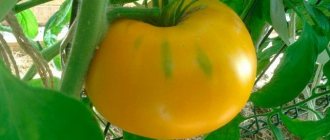The Hercules pepper, described below, is very popular with experienced gardeners for several of its characteristics, including its incredible "vitality" and amazing fruity taste. Today we will take a closer look at this variety of pepper, talk about the conditions for its cultivation, features of care, yield and reviews of truck farmers.
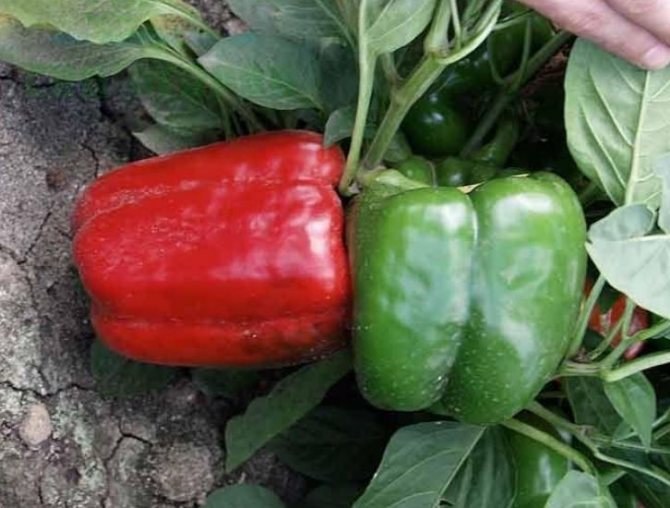
Description
The Hercules f1 pepper variety is medium-term. The ripening period of the fruit, starting from sowing, is about 75 days. The plant is characterized by a rather compact size, a developed root system and good leafiness (which is important for regions with hot summers), and you will also be interested to know:
- Fetus. They develop on pepper bushes evenly at the same time. In one bush, an average of about 8-10 fruits ripen. The fruits grow very large and massive. The length can reach 11-12 cm, the diameter of the pepper is about 10 cm.The weight of one fruit is about 230-250 g. Individual samples can weigh 300 g. The ripe fruit has a cuboid shape with four ribs, the flesh is very fleshy, juicy, the walls are significant ( 0.5-1 cm).
- Color fruit in a state of technical maturity is dark green, in a biological state - fire red.
- Taste. Separately, it should be said about the taste of the fruits of the Hercules f1 variety: the taste is rich, with a significant share of sweetness and a little bitterness inherent in variety, which makes this pepper very spicy.
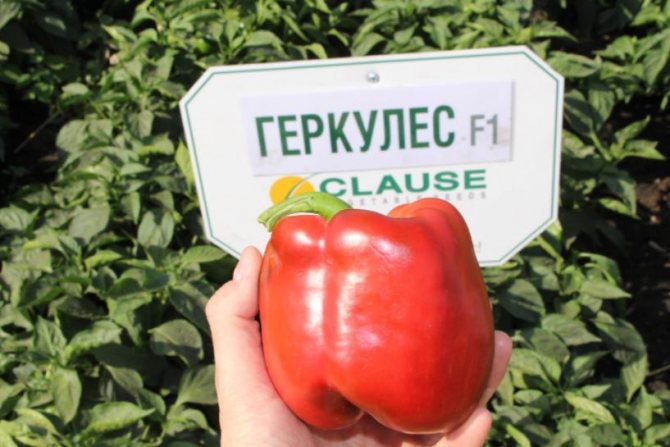

Gardeners in their reviews describe this diversity extremely positively. Among the most significant benefits of Hercules pepper can be noted as follows:
- Excellent yields - when grown in greenhouse conditions from one bush, you can harvest up to 3.5 kg of large beautiful fruits, when grown outdoors - about 2 kg of fruit.
- Excellent shelf life.
- The appearance of almost 100% ripening fruits - due to the excellent appearance of the fruits, they are ideal not only for domestic agriculture, but also for trade.
- Abundant and long-term fruiting.
- High resistance to lack of sufficient humidity and high summer temperatures.
- High resistance to most pepper diseases.
Pepper Hercules, video
This video describes the characteristics of the Hercules bell pepper, lists the main advantages over other varieties and hybrids. Truly a giant pepper.
If you have grown Hercules bell peppers, please write whether you like it or not. What was the yield under your conditions? How do you rate the disease resistance of this hybrid? If possible, attach a photo of the entire bush or individual fruits grown by you to the commentary. Thank you!
Your reviews about Hercules pepper and additions to the description will help evaluate this hybrid more objectively and decide whether to plant it or not.
Pepper shaping, video
Growing
It should be noted right away that Hercules f1 peppers are very picky: this will require high-quality fertilizers, constant monitoring of growing bushes, mulching if necessary, plant protection, etc.
The cultivation of pepper is carried out exclusively by the seedling method. Seeds should be preliminarily prepared in accordance with the standard scheme - selection of viable samples, disinfection of seed material:
- The first step is done by visually comparing the seeds to each other or using a saline solution (remember to wash the seeds afterwards).
- And the second - using a weak manganese solution. After undergoing pre-treatment, the seeds must be properly dried.
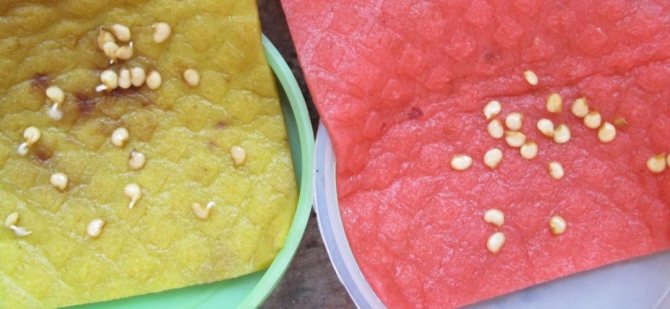

Since the variety is quite sensitive to cold, sowing seeds on seedlings should be carried out approximately by the end of March, when the air temperature stably reaches + 15 degrees.
Since a distinctive feature of any pepper variety is a weak root system of young shoots, it is better to sow the crop in separate peat pots:
- The maximum immersion depth of seeds in a moistened soil substrate is about 1 cm.
- In the first weeks, the seeds will require a sufficient amount of heat, so the peat pots should be placed in a warm, well-lit room with an air temperature of at least 16 degrees.
- If all planting conditions are met, the first seedlings should appear in a week.
- Planting seedlings in soil is approximately 40-50 days after sowing the seeds.
- The main sign of the "readiness" of a young plant for transplanting is the presence of at least 5-6 full leaves.
Expert opinion
Filatov Ivan Yurievich, private farmer for over 30 years
It is important to properly load the seedlings into the soil: the plant's neck should look outward. Otherwise, you will condemn the culture to a meaningless action - the development of a subordinate root system.
Seedling peppers
The Hercules variety is grown by the seedling method. The seeds are germinated at home. Before starting work, prepare the soil and planting material. When the pepper grows up, it is transferred to a permanent place in an open area, in a greenhouse or greenhouse.
Preparing for landing
Hercules seeds are planted in March or February. They are pre-wrapped in a damp cloth and kept warm for a couple of days. This treatment stimulates the emergence of sprouts.
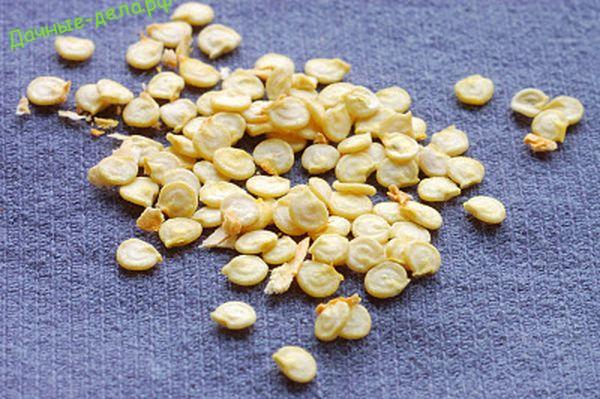

If the seeds have a bright colored shell, then they are not processed before planting. Such planting material has a nutritious shell, due to which the seedlings develop faster.
The soil for planting varieties Hercules is prepared from the following components:
- humus - 2 parts;
- coarse river sand - 1 part;
- land from the site - 1 part;
- wood ash - 2 tbsp. l.
The resulting soil is heated for 15 minutes in a microwave or oven. Boxes or individual cups are prepared for seedlings. One option is to use peat pots.
If you grow Hercules peppers in boxes, then when 1-2 leaves appear, it must be dived into separate containers. The culture does not tolerate such changes in conditions, so picking should be avoided whenever possible.
Advice! Hercules pepper seeds are deepened into the soil by 2 cm.
The crops are watered and the containers are placed under glass or film. Seed germination occurs at temperatures above 20 degrees. The emerging seedlings are transferred to the window.
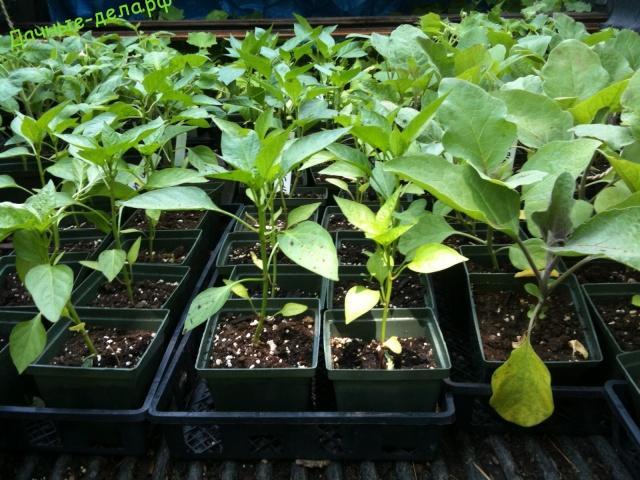

Seedling conditions
Seedlings of the Hercules variety provide certain conditions:
- temperature regime (in the daytime - no more than 26 degrees, at night - about 12 degrees);
- moderate soil moisture;
- regular watering with warm, settled water;
- airing the room;
- lack of drafts;
- increased air humidity due to spraying.
Before transferring the plants to a permanent place, they are fed twice with Agricola or Fertik fertilizer. A break of 2 weeks is taken between treatments.
Young plants need hardening 2 weeks before planting. They are transferred to a balcony or loggia, first for several hours, then this interval is gradually increased. Then the transplant will bring less stress to the peppers.
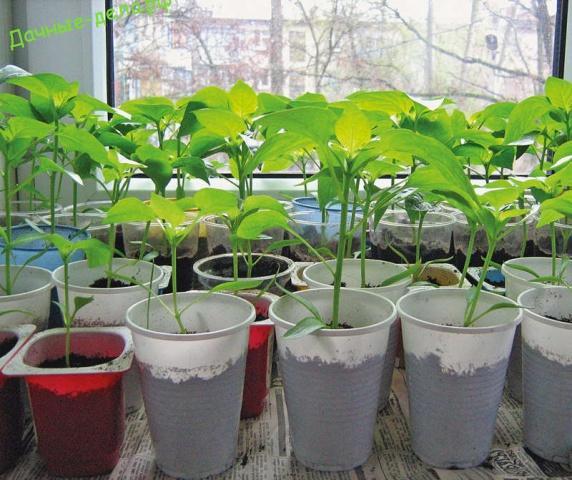

Care
In the process of active growth of bushes, it is important to monitor the formation of stepchildren and remove them in a timely manner.Plant formation is carried out in one stem (if it is an open area) or in two stems (when sowing in a greenhouse).
When the first fruits begin, the pepper should be "helped", reinforced with a small wooden support. Otherwise, the bushes will begin to bend to the ground under the weight of massive fruits.
As for the irrigation, it must drip. This way you can save time while maximizing the effect. The soil will be moistened locally and in moderation - excess moisture will only cause damage to the pepper.
Does excessive moisture always affect the quality of the pepper?
Well no
Hercules f1 pepper does not require many additional dressings. It is enough just to make a nitrogen-mineral complex about a couple of weeks after planting in the ground and repeat the procedure after a couple of days. The last top dressing is introduced at the beginning of the fruiting period.
Gardeners reviews
Love, 39 years old, Kazan
I chose the Hercules F1 pepper according to reviews and did not regret it at all. This is the sweetest pepper I have tasted. Some fruits reached 400 g. Their walls are thick, and the yield is very high. Among the disadvantages is slow staining. I took off the harvest at the end of August. The taste of the variety is excellent, it goes well for preparations and salads.
Vladimir, 58 years old, Voronezh
I planted the Hercules variety 5 years ago. Since then, I have definitely bought his seeds for planting. I grow it using the standard seedling method, then transfer the plants to a greenhouse. There are always a lot of leaves on the bushes, I leave 4 shoots on them. But in the heat, the fruits are protected from the sun. You can leave 50 cm between the bushes, this is quite enough for the normal development of peppers.
Svetlana, 34 years old, Stavropol
A couple of years ago, a friend suggested trying Hercules pepper. At first I did not believe that such delicious vegetables could be grown. In the spring I decided to plant this variety in the country. I was worried that the seedlings would not sprout, but the seeds sprouted together, and the sprouts then developed well. The peppers ripened on the bushes for a long time, but when I collected them, the taste was excellent. Next year I think to repeat the landing.
Diseases and pests
The Hercules variety is not subject to a number of diseases:
- bacterial spotting;
- tobamovirus;
- tobacco mosaic and late blight.
Viral diseases are the most dangerous for pepper. To combat them, destroy the affected plants and change the planting site.
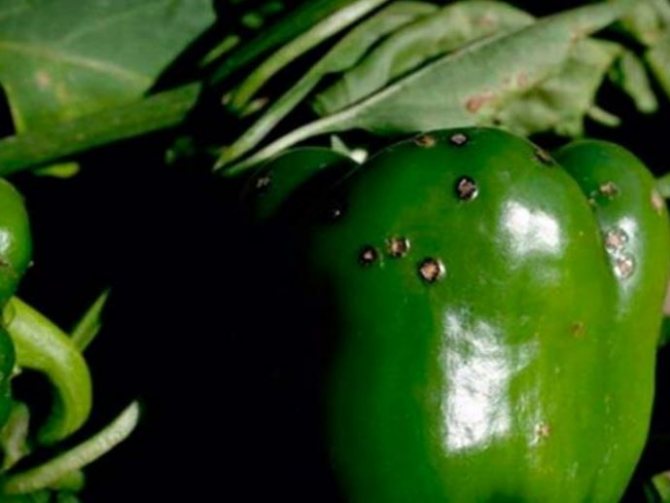

Fungal diseases spread in thickened stands with high humidity. With them you can fight drugs:
- Fundazol;
- Oxihom;
- Akara and Zaslon.
If the agent contains copper compounds, the treatment is carried out before flowering and after harvesting the fruit.
The Hercules variety is attacked by pests that feed on cell sap, roots and leaves. The effective insecticides Keltan or Carbophos are effective against insects and are used as directed. From folk remedies, an infusion of onion peels, tobacco dust, wood ash is used.
Planting peppers
The Hercules variety is planted in open areas, hotbeds or greenhouses. The transplant is carried out at the end of May, when the air temperature rises to 15 degrees.
Pepper prefers light soils with low acidity. The preparation of the beds is carried out in the fall, when the soil is dug up, they are applied to 1 sq. m rotted manure (5 kg), double superphosphate (25 g) and potassium sulfate (50 g).
Advice! In the spring, the soil is re-dug up and 35 g of ammonium nitrate is added.
The place for growing the Hercules variety is chosen depending on the culture that previously grew on it. Good precursors for peppers are courgettes, cucumbers, onions, pumpkin, and carrots.
It is not recommended to plant if any varieties of peppers, eggplants, potatoes, tomatoes have previously grown in the garden. These crops have common diseases that can be transferred to new plantings.
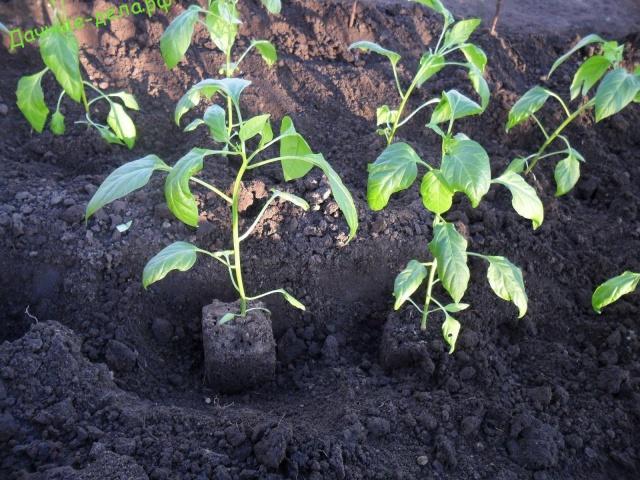

The order of planting peppers Hercules:
- Preparation of holes 15 cm deep.
- The holes are placed in increments of 40 cm. 40 cm are also left between the rows.
- Add 1 tbsp to each pit. l. complex fertilizer, including potassium, phosphorus and nitrogen.
- The plants are moved into the pits along with the earthen clod.
- The roots of the peppers are covered with earth, which is lightly tamped.
- Plants are watered abundantly.
After transplanting, the peppers need about 10 days to adapt. During this period, no moisture or fertilizer is applied.
Photo
The photo shows Hercules pepper.
Planting seeds
Hercules is grown in seedlings. It is best to plant seeds in March. All planting material is soaked in a weak solution of manganese, kept there for about fifteen minutes. The seeds are dried, sown in containers filled with a fertilized soil composition. For sowing, it is recommended to use cassettes or peat pots.
Growing conditions for seedlings
To create a greenhouse effect, containers must be covered with cellophane or a piece of glassso that the seeds germinate as quickly as possible. The soil is moistened from time to time.
As soon as the first shoots appear, mineral supplements can be applied... Young seedlings are transferred to a cooler room, hardening begins a couple of weeks before transplanting into unprotected soil.
Open ground transplant
This is best done at the end of May, when warm weather sets in and the soil composition warms up. Landing pattern - forty by sixty centimetersso that the plants do not interfere with each other's development.
Beneficial features
The sweet variety Hercules is the leader among vegetables in terms of the content of vitamins and microelements. Thanks to them, it has a positive effect on human health:
- fruits contain the alkaloid capsacin, which reduces blood pressure, improves gastrointestinal secretion, increases appetite, and thins the blood;
- due to the content of vitamins A and C, the condition of the skin, eyesight, nails, hair improves, immunity increases;
- due to the content of B vitamins, the fruits are recommended for use in case of stress, neurosis and insomnia;
- vitamins P and C strengthen and increase the elasticity of blood vessels;
- the vegetable is rich in calcium, iodine, iron, magnesium and zinc.
If you follow simple guidelines for growing, the Hercules variety will delight you with an abundant tasty harvest, because there is nothing more pleasant than bright, juicy vegetables grown by your own hands.

